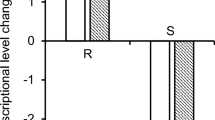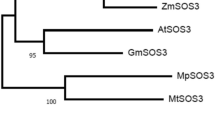Abstract
Lipid transfer proteins (LTPs) are widely distributed in the plant kingdom, but their functions remain elusive. The proteins AlLTP2-4 were isolated from three related Allium plants: garlic (A. sativum L.), Welsh onion (A. fistulosum L.), and Nanking shallot (A. ascalonicum L.). These novel proteins comprise a new class of LTPs associated with the Ace-AMP1 from onion (A. cepa L.). The AlLTP genes encode proteins harboring 132 common amino acids and also share a high level of sequence identity. Protein characteristics and phylogenetic analysis suggest that LTPs could be classified into five distinct groups. The AlLTPs were clustered into the most distantly related plant LTP subfamily and appeared to be restricted to the Allium species. In particular, the number of amino acids existing between the fourth and fifth Cys residue was suggested as a conserved motif facilitating the categorization of all the LTP-related proteins in the family. Unlike other LTPs, AlLTPs harboring both the putative C-terminal propeptide and N-terminal signal peptide were predicted to be localized to cytoplasmic vacuoles. When a chimeric GFP protein fused with both N-terminal and C-terminal AlLTP2 signal peptides was expressed in rice cells, the fluorescence signal was detected in the endomembrane compartments, thereby confirming that AlLTPs are an unprecedented intracellular type of LTP. Collectively, our present data demonstrate that AlLTPs are a novel type of LTP associated with the Allium species.



Similar content being viewed by others
References
Arondel V, Vergnolle C, Cantrel C, Kader J-C (2000) Lipid transfer proteins are encoded by a small multigene family in Arabidopsis thaliana. Plant Sci 157:1–12
Arora D, Kaur J (1999) Antimicrobial activity of spices. Int J Antimicrob Agents 12:257–262
Beisson F, Koo AJK, Ruuska S, Schwender J, Pollard M, Thelen JJ, Paddock T, Salas JJ, Savage L, Milcamps A, Mhaske VB, Cho Y, Ohlrgge JB (2003) Arabidopsis genes involved in acyl lipid metabolism. A 2003 census of the candidates, a study of the distribution of expressed sequence tags in organs, and a web-based database. Plant Physiol 132:681–697
Bi Y-M, Cammue BPA, Goodwin PH, KrishnaRaj S, Saxena PK (1999) Resistance to Botrytis cinerea in scented geranium transformed with a gene encoding the antimicrobial protein Ace-AMP1. Plant Cell Rep 18:835–840
Blein J-P, Coutos-Thevenot P, Marion D, Ponchet M (2002) From elicitins to lipid-transfer proteins: a new insight in cell signaling involved in plant defense mechanisms. Trends in Plant Sci 7:293–296
Boutrot F, Guirao A, Alary R, Joudrier P, Gautier M-F (2005) Wheat non-specific lipid transfer protein genes display a complex pattern of expression in developing seeds. Biochem Biophys Acta 1730:114–125
Cammue BPA, Thevissen K, Hendriks M, Eggermont K, Foderis IJ, Proost P, Van Damme J, Osborm RW, Guerbette F, Kader JC, Broekaert WF (1995) A potent antimicrobial protein from onion seeds showing sequence homology to plant lipid transfer proteins. Plant Physiol 109:445–455
Carvalho AO, Souza-Filho GA, Ferreira BS, Baranco AT, Araujo IS, Fernandes KVS, Retamal CA, Gomes VM (2006) Cloning and characterization of a cowpea seed lipid transfer protein cDNA: expression analysis during seed development and under fungal and cold stresses in seedlings’ tissues. Plant Physiol Biochem 44:732–742
Castro MS, Gerhardt IR, Orrus S, Pucci P, Bloch C Jr (2003) Purification and characterization of a small (73 kDa) putative lipid transfer protein from maize seeds. J Chromatogr B 794:109–114
Cheng C-S, Samuel D, Liu Y-J, Shyu J-C, Lai S-M, Lin K-F, Lyu P-C (2004) Binding mechanism of nonspecific lipid transfer proteins and their role in plant defense. Biochemistry 43:13628–13636
Douliez JP, Michon T, Elmorjani K, Marion D (2000) Structure, biological and technological functions of lipid transfer proteins and indolines, the major lipid binding proteins from cereal kernels. J Cereal Sci 32:1–20
Douliez J-P, Pato C, Rabesona H, Molle D, Marion D (2001) Disulfide bond assignment, lipid transfer activity and secondary structure of a 7-kDa plant lipid transfer protein, LTP2. Eur J Biochem 268:1400–1403
Federico ML, Kaeppler HF, Skadsen RW (2005) The complex developmental expression of a novel stress-responsive barley Ltp gene is determined by a shortened promoter sequence. Plant Mol Biol 57:35–51
Guiderdoni E, Cordero MJ, Vignols F, Garcia-Garrido JM, Lescot M, Tharreau D, Meynard D, Ferriere N, Notteghem J-L, Delseny M (2002) Inducibility by pathogen attack and developmental regulation of the rice Ltp1 gene. Plant Mol Biol 49:683–699
Hanson MR, Köhler RH (2001) GFP imaging: methodology and application to investigate cellular compartmentation in plants. J Exp Bot 52:529–539
Hollenbach B, Schreiber L, Hatrung W, Dietz KJ (1997) Cadmium leads to stimulated expression of the lipid transfer protein genes in barley: implications for the involvement of lipid transfer proteins in wax assembly. Planta 203:9–19
Hong S-T, Lee M-Y, Kim S-R (2001) Molecular cloning of the anther-preferential nonspecific lipid transfer protein cDNA in hot pepper by mRNA differential display. Mol Cells 11:241–249
Jang I-C, Nahm B-H, Kim J-K (1999) Subcellular targeting of green fluorescent protein to plastids in transgenic rice plants provides a high-level expression system. Mol Breed 5:453–461
Jang I-C, Choi W-B, Lee K-H, Song SI, Nahm B-H, Kim J-K (2002) High-level and ubiquitous expression of the rice cytochrome c gene OsCc1 and its promoter activity in transgenesis of monocots. Plant Physiol 129:1473–1481
Jang I-C, Park Y-M, Song SI, Kwon HJ, Nahm BH, Kim J-K (2003) Structure and expression of the rice class-I type histone deacetylase genes OsHDAC1–3: OsHDAC1 overexpression in transgenic plants leads to increased growth rate and altered architecture. Plant J 33:531–541
Jung HW, Kim W, Hwang BK (2003) Three pathogen-inducible genes encoding lipid transfer protein from pepper are differentially activated by pathogens, abiotic, and environmental stresses. Plant Cell Environ 26:915–928
Kader J-C (1996) Lipid-transfer proteins in plants. Ann Rev Plant Physiol Plant Mol Biol 47:627–654
Kader J-C (1997) Lipid-transfer proteins: a puzzling family of plant proteins. Trends Plant Sci 2:66–70
Lauga B, Charbonnel-Campaa L, Combes D (2000) Characterization of MZm3–3, a Zea mays tapetum-specific transcript. Plant Sci 157:65–75
Lee MC, Kim YH, Yun DW, Ma BC, Nahm BH, Eun MY (1999) Cloning and sequence analysis of cDNA encoding lipid-transfer proteins from Rice. Plant Physiol 120:339
Li X, Gasic K, Cammue B, Broekaert W, Korban SS (2003) Transgenic rose lines harboring an antimicrobial protein gene, Ace-AMP1, demonstrate enhanced resistance to powder mildew (Sphaerotheca pannosa). Planta 218:226–232
Lin K-F, Lin Y-N, Hsu S-T D, Samuel D, Cheng C-S, Bonvin AMJJ, Lyu P-C (2005) Characterization and structural analyses of nonspecific lipid transfer protein 1 from mung bean. Biochemistry 44:5703–5712
Liu Y-J, Samuel D, Lin C-H, Lyu P-C (2002) Purification and characterization of a novel 7-kDa non-specific lipid transfer protein-2 from rice (Oryza sativa). Biochem Biophys Res Commun 294:535–540
Liu K, Jiang H, Moore SL, Watkins CB, Jahn MM (2006) Isolation and characterization of a lipid transfer protein expressed in ripening fruit of Capsicum chinense. Planta 223:672–683
Maldonado AM, Doerner P, Dixon RA, Lamb CJ, Cameron RK (2002) A putative lipid transfer protein involved in systemic resistance signaling in Arabidopsis. Nature 419:399–403
Marion D, Bakan B, Elmorjani K (2007) Plant lipid binding proteins: properties and applications. Biotechnol Adv 25:195–197
Marty F (1999) Plant vacuoles. Plant Cell 11:587–599
Masuta C, Furuno M, Tanaka H, Yamada M, Koiwai A (1992) Molecular cloning of a cDNA clone for tobacco lipid transfer protein and expression of the functional protein in Escherichia coli. FEBS Lett 311:119–123
Mlynarova L, Loonen A, Heldens J, Jansen RC, Kerzer P, Stiekema WJ, Nap JP (1994) Reduced position effect in mature transgenic plants conferred by the chicken lysozyme matrix-associated region. Plant Cell 6:417–426
Mo B, Tse YC, Jiang L (2006) Plant prevacuolar/endosomal compartments. Int Rev Cytol 253:95–129
Monnet F-P, Dieryck W, Boutrot F, Joudrier P, Gautier M-F (2001) Purification, characterization and cDNA cloning of a type 2 (7 kDa) lipid transfer protein from Triticum durum. Plant Sci 161:747–755
Neuhaus J-M, Rogers JC (1998) Sorting of proteins to vacuoles in plant cells. Plant Mol Biol 38:127–144
Nieuwland J, Feron R, Huisman BAH, Fasolino A, Hilvers CW, Derksen J, Mariani C (2005) Lipid transfer proteins enhance cell wall extension in tobacco. Plant Cell 17:2009–2019
Park C-J, Shin R, Park JM, Lee G-J, You J-S, Paek K-H (2002) Induction of pepper cDNA encoding a lipid transfer protein during the resistance response to tobacco mosaic virus. Plant Mol Biol 48:243–254
Roy-Barman S, Sautter C, Chattoo B (2006) Expression of the lipid transfer protein Ace-AMP1 in transgenic wheat enhances antifungal activity and defense responses. Transgenic Res 15:435–446
Sabala I, Elfstrand M, Farbos I, Clapham D, von Arnold S (2000) Tissue-specific expression of Pa18, a putative lipid transfer protein gene, during embryo development in Norway spruce (Picea abies). Plant Mol Biol 42:461–478
Skriver K, Leah R, Muller-Uri F, Llsen FL, Mundy J (1992) Structure and expression of the barley lipid transfer protein gene Ltp1. Plant Mol Biol 18:585–589
Tassin S, Broekaert WF, Marion D, Acland DP, Ptak M, Vovelle F, Sodano P (1998) Solution structure of Ace-AMP1, a potent antimicrobial protein extracted from onion seeds Structural analogies with plant nonspecific lipid transfer proteins. Biochemistry 37:3623–3637
Vitale A, Denecke J (1999) The endoplasmic reticulum-Gateway of the secretory pathway. Plant Cell 11:615–628
Vitale A, Raikhel NV (1999) What do proteins need to reach different vacuoles? Trends Plant Sci 4:149–155
Wang SY, Wu JH, Ng TB, Ye XY, Rao PF (2004) A non-specific lipid transfer protein with antifungal and antibacterial activities from the mung bean. Peptides 25:1235–1242
Wu Z, Burns JK (2003) Isolation and characterization of a cDNA encoding a lipid transfer protein expressed in ‘Valencia’ orange during abscission. J Exp Bot 54:1183–1191
Yubero-Serrano E-M, Moyano E, Medina-Escobar N, Munoz-Blanco J, Caballero J-L (2003) Identification of a strawberry gene encoding a non-specific lipid transfer protein that responds to ABA, wounding and cold stress. J Exp Bot 54:1865–1877
Acknowledgments
This work was supported by the Ministry of Education, Science and Technology, Korea, through the Crop Functional Genomics Center (grants to Y.D.C and J.-K.K).
Author information
Authors and Affiliations
Corresponding author
Rights and permissions
About this article
Cite this article
Yi, SI., Park, MY., Kim, JK. et al. AlLTPs from Allium species represent a novel class of lipid transfer proteins that are localized in endomembrane compartments. Plant Biotechnol Rep 3, 213–223 (2009). https://doi.org/10.1007/s11816-009-0094-7
Received:
Accepted:
Published:
Issue Date:
DOI: https://doi.org/10.1007/s11816-009-0094-7




